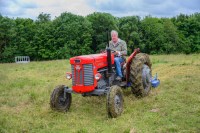A real-life Wind in the Willows war has broken out. Except this time, the war isn’t between the Weasels and Badger (he’s busy fighting another battle), and the story has relocated from a Berkshire riverbank to the Scottish Highlands.
This battle is between the pine marten – a weasel-type animal – and the capercaillie, a turkey-sized bird in the grouse family. So what, exactly, is the problem? Well, for starters, both species are protected and endangered in the UK, but pine martens are currently doing pretty well in terms of numbers. They might have been almost extinct at the beginning of the 20th century, but have now made a comeback – which is more than can be said for the capercaillie.
There are estimated to be around 3,500 pine martens in Scotland, while there are at most 1,200 capercaillie, which are restricted to the Caledonian pine forest. It’s an understatement to say that the two species don’t get on – it’s well known in the Highlands that in areas with lots of pine marten, capercaillie are few and far between. And in a 2009 study of capercaillie nests, it was recorded that over half of the destroyed nests had been destroyed by pine martens.
As a result, the Scottish Gamekeepers Association are warning that unless something is done about pine marten numbers, capercaillie could soon become extinct – for the second time – in Britain. Their solution? To ‘remove’ a certain number of martens to reduce predation. They claim that the RSPB ‘cannot be trusted to make an unbiased decision’ about how to ensure the future of the capercaillie in the UK, and are ‘letting them die out in the name of political correctness’.
The SGA believe that the RSPB are worried that controlling predator numbers could also lead to legislation regarding the culling of raptors (the protection of which is one of the RSPB’s pet projects) and argue that they shouldn’t be in charge of such a large proportion of the money which has been put aside to protect ‘the horse of the woods’.
So who is in the right? It’s no surprise that the RPSB are keen to avoid the type of negative publicity that the RSPCA have received in the last year or so. But it’s striking that the RSPB weren’t against the idea of culling hedgehogs in the Western Isles in 2002, when it was believed that the decline in the numbers of wading birds in the islands was due to an excess of hedgehogs making the most of easily accessible – and tasty – birds’ eggs.
I have to admit to a certain soft spot for the pine marten. Ever since the one who’d made its home in our loft decided to pee just above where my father was sitting, I’ve been convinced of their supreme intelligence. But it is true that they are vicious and fearless predators; a capercaillie nest – or any other nest for that matter – would stand little chance.
So what’s the solution? Well, when it boils down to rare bird v. rare mammal, it’s not always easy to make a call. The Mammal Society have, perhaps unsurprisingly, been standing up for the pine marten, arguing that the reduction in capercaillie numbers began before pine marten spread into their breeding areas, and that their numbers have been affected by a reduction in decent woodland and changes in the Scottish weather, rather than specifically due to predation by marten.
It’s always going to be an uneasy decision to choose one animal over another. It’s true that the two do exist side-by-side in other countries. But when their natural habitat is so restricted, as they are in Scotland, it’s hard to envisage a similar future for them here.







Comments